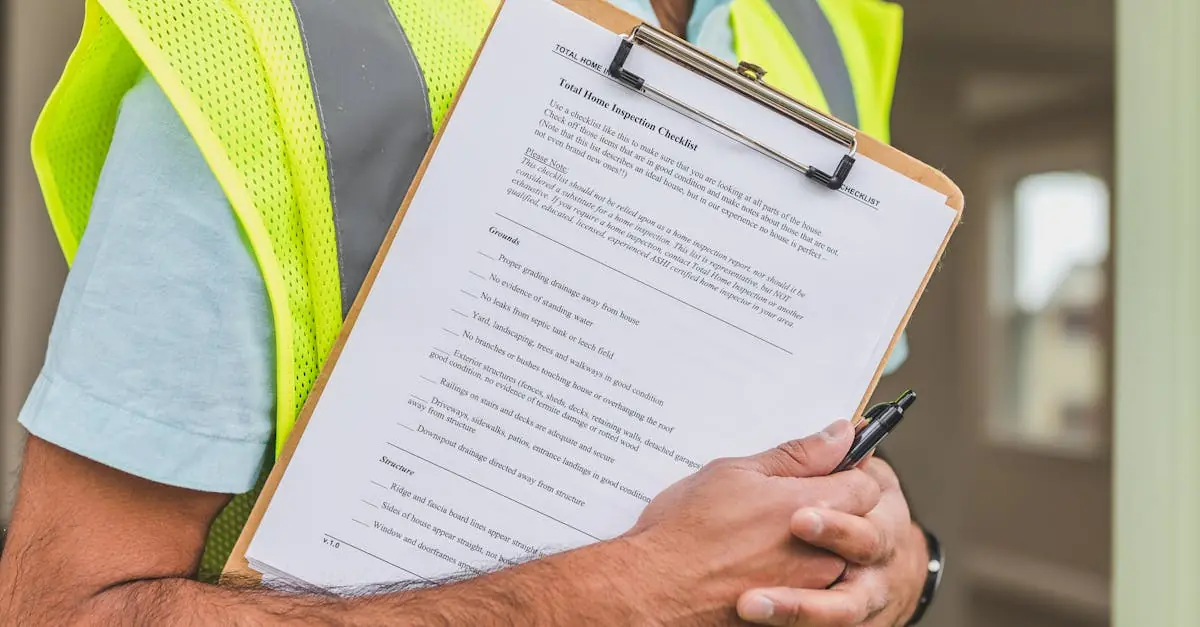Table of Contents
ToggleIn the hustle and bustle of daily life, keeping track of everything can feel like herding cats. A weekly maintenance checklist is your secret weapon, ensuring that nothing slips through the cracks while you juggle work, family, and that mysterious sock monster lurking in the laundry.
Importance Of A Weekly Maintenance Checklist
A weekly maintenance checklist serves as an essential tool for staying organized in both personal and professional settings. This resource helps prevent oversights and reinforces accountability in routine tasks.
Benefits For Homeowners
Homeowners experience several advantages from utilizing a weekly maintenance checklist. First, it enhances home safety by prompting regular inspections of smoke detectors and carbon monoxide detectors. Second, the checklist aids in identifying potential issues, such as leaks or electrical problems, before they escalate. Third, routine maintenance, like gutter cleaning or HVAC checks, prolongs the life of home systems and appliances. Fourth, it encourages energy efficiency by ensuring that heating and cooling functions work optimally. Lastly, homeowners can increase property value through consistent upkeep and improvements.
Benefits For Businesses
Businesses benefit significantly from a weekly maintenance checklist as well. First, it promotes operational efficiency by ensuring equipment is properly serviced and functioning. Second, the checklist minimizes downtime, which directly impacts productivity. Third, it assists with regulatory compliance by facilitating regular inspections and maintenance of safety equipment. Fourth, businesses can maintain a clean workspace, enhancing employee morale and customer satisfaction. Lastly, consistent maintenance reduces unexpected repair costs, leading to better budget management.
Key Components Of A Weekly Maintenance Checklist
A comprehensive weekly maintenance checklist includes key tasks that ensure systems operate efficiently and structures remain safe. Regular attention to both the exterior and interior of properties can prevent costly repairs down the road.
Exterior Maintenance
Exterior maintenance covers all aspects of a property’s outside structure. Checking roofs for damage or leaks helps prevent water intrusion. Landscaping requires attention by trimming shrubs and mowing lawns to maintain aesthetics. Inspecting gutters for debris keeps water flowing and protects the foundation. Additionally, examining fences for stability ensures they can withstand weather conditions.
Interior Maintenance
Interior maintenance focuses on areas that contribute to comfort and safety within a home or business. Cleaning air filters improves air quality and HVAC efficiency. Testing smoke detectors and carbon monoxide detectors ensures they function properly, enhancing safety. Checking plumbing for leaks reduces water waste and potential damage. Inspecting electrical outlets for any signs of wear or malfunction helps prevent fire hazards.
Equipment Checks
Equipment checks involve reviewing all appliances and machinery for efficiency. Cleaning kitchen appliances maintains optimal performance and prolongs lifespan. Inspecting HVAC systems guarantees they run smoothly and efficiently, saving energy costs. Testing generators ensures they function correctly during emergencies. Evaluating power tools and machinery ensures safe operation and prevents breakdowns, facilitating continuous productivity.
Creating An Effective Weekly Maintenance Checklist
An effective weekly maintenance checklist tailors to specific needs, ensuring that essential tasks receive attention.
Customizing For Your Needs
Customization enhances the utility of a weekly maintenance checklist. Identifying specific priorities allows individuals to focus on tasks that matter most. Homeowners might prioritize seasonal tasks, such as gutter cleaning, while businesses could emphasize equipment checks that minimize downtime. Additionally, adapting the checklist according to changing circumstances helps maintain relevance. Infusing personal touches enables better tracking of completed tasks, reinforcing a sense of accomplishment.
Digital vs. Paper Checklists
Choosing between digital and paper checklists depends on individual preferences. Digital checklists offer convenience with reminders and accessible organization. Using apps allows for easy sharing and collaborative input, particularly beneficial in team environments. Conversely, paper checklists provide a tangible method that some people find more satisfying. Writing down tasks can enhance memory retention, potentially increasing accountability. Ultimately, selecting the right format serves individual needs while maximizing checklist effectiveness.
Tips For Staying On Track
Staying on track with a weekly maintenance checklist enhances organization and efficiency. Implementing straightforward strategies can assist in maintaining focus on essential tasks.
Setting Reminders
Setting reminders ensures tasks remain front of mind. Utilize digital tools to create alerts on smartphones or computers. Notifications can be scheduled weekly, providing timely prompts for each task. Some prefer a simple calendar system, allowing visualization of tasks throughout the week. Adjusting notification settings can help personalize reminders according to individual preferences. This structured approach helps create accountability and keeps maintenance tasks prioritized.
Involving Your Team
Involving your team fosters collaboration and shared responsibility. Encourage team members to contribute to the checklist’s development, ensuring comprehensive coverage of necessary tasks. Assigning specific duties promotes ownership, making individuals more accountable for respective areas. Regular meetings can be implemented to check progress and discuss any roadblocks. Recognizing achievements also boosts morale and reinforces commitment to maintenance goals. This supportive environment can improve overall performance and ensure every task remains prioritized within the organizational framework.
Conclusion
A weekly maintenance checklist is an essential tool for navigating the complexities of daily life. By implementing this straightforward strategy individuals can streamline their routines and enhance their living or working environments.
Whether for a home or a business the benefits are clear. Regular maintenance not only improves safety and efficiency but also protects investments over time. Customizing the checklist to fit specific needs ensures that priorities are met effectively.
With the right approach and tools individuals can take charge of their maintenance tasks. This proactive mindset fosters a sense of achievement and helps maintain an organized and efficient lifestyle.








